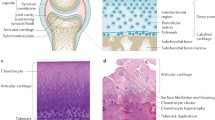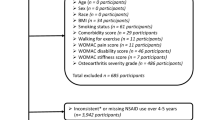Abstract
Osteoarthritis (OA) is not a simple consequence of “wear and tear” or aging—the presence of cytokines suggests a role for inflammation. OA is polyarticular in most patients, with metabolic and differential risk factors for prevalence and severity. Odds ratios for the prevalence of OA according to formal education levels are similar to those seen for dysregulatory diseases such as hypertension, diabetes, and rheumatoid arthritis. Clinical survey data indicate significant patient preference for nonsteroidal anti-inflammatory drugs (NSAIDs) compared with acetaminophen. A recent crossover clinical trial indicated significantly greater efficacy of the NSAID, diclofenac/misoprostol, versus acetaminophen for most patients with OA.
Similar content being viewed by others
References and Recommended Reading
Huskisson EC, Dieppe PA, Tucker AK, Cannell LB: Another look at osteoarthritis. Ann Rheum Dis 1979, 38:423–428.
Pelletier JP, Martel-Pelletier J, Abramson SB: Osteoarthritis, an inflammatory disease - potential implication for the selection of new therapeutic targets. Review. Arthritis Rheum 2001, 44:1237–1247. An outstanding review documenting evidence for chondrocytes as a source of matrix metalloproteinase, proinflammatory cytokines, including TNFa and IL-1b, nitric oxide, and prostaglandins in osteoarthritis. The implication for new therapeutic approaches is elegantly discussed.
van de Loo FAJ, Joosten LAB, van Lent PLEM, et al.: Role of interleukin-1, tumor necrosis factor alpha, and interleukin-6 in cartilage proteoglycan metabolism and destruction. Effect of in situ blocking in murine antigen- and zymosan-induced arthritis. Arthritis Rheum 1995, 38:164–172.
Caron JP, Fernandes JC, Martel-Pelletier J, et al.: Chondroprotective effect of intraarticular injections of interleukin-1 receptor antagonist in experimental osteoarthritis. Suppression of collagenase-1 expression. Arthritis Rheum 1996, 39:1535–1544.
Hirsch R, Lethbridge-Cejku M, Scott WW, et al.: Association of hand and knee osteoarthritis: Evidence for a polyarticular disease subset. Ann Rheum Dis 1996, 55:25–29.
Hochberg MC, Lane NE, Pressman AR, et al.: The association of radiographic changes of osteoarthritis of the hand and hip in elderly women. J Rheumatol 1995, 22:2291–2294.
Hart DJ, Doyle DV, Spector TD: Association between metabolic factors and knee osteoarthritis in women: The Chingford study. J Rheumatol 1995, 22:1118–1123.
Anderson JJ, Felson DT: Factors associated with osteoarthritis of the knee in the first national health and nutrition examination survey (HANES I): evidence for an association with overweight, race and physical demands of work. Am J Epidemiol 1988, 128:179–189.
Davis MA, Ettinger WH, Neuhaus JM: The role of metabolic factors and blood pressure in the association of obesity with osteoarthritis of the knee. J Rheumatol 1988, 15:1827–1832.
Martin K, Lethbridge-Cejku M, Muller DC, et al.: Metabolic correlates of obesity and radiographic features of knee osteoarthritis: Data from the Baltimore longitudinal study of aging. J Rheumatol 1997, 24:702–707.
Cooper C, McAlindon T, Snow S, et al.: Mechanical and constitutional risk factors of symptomatic knee osteoarthritis: Difference between medial tibiofemoral and patellofemoral disease. J Rheumatol 1994, 21:307–313.
McAlindon T, Zhang Y, Hannan M, et al.: Are risk factors for patellofemoral and tibiofemoral knee osteoarthritis different? J Rheumatol 1996, 23:332–337.
Antonovsky A: Social class and the major cardiovascular diseases. J Chronic Dis 1968, 21:65–106.
Kitagawa EM, Hauser PM: Differential Mortality in the United States: A Study in Socioeconomic Epidemiology. Cambridge: Harvard University Press; 1973.
Marmot MG, Kogevinas M, Elston MA: Social/economic status and disease. Annu Rev Public Health 1987, 8:111–135.
Sagan LA: The health of nations: true causes of sickness and well-being. New York: Basic Books; 1987.
Weinblatt E, Ruberman W, Goldberg JD, et al.: Relation of education to sudden death after myocardial infarction. N Engl J Med 1978, 299:60–65.
Adler NE, Boyce WT, Chesney MA, et al.: Socioeconomic inequalities in health: No easy solution. JAMA 1993, 269:3140–3145.
Pincus T: Formal educational level—a marker for the importance of behavioral variables in the pathogenesis, morbidity, and mortality of most diseases? Editorial. J Rheumatol 1988, 15:1457–1460.
Pincus T, Callahan LF: Formal education as a marker for increased mortality and morbidity in rheumatoid arthritis. J Chronic Dis 1985, 38:973–984.
Pincus T, Callahan LF, Burkhauser RV: Most chronic diseases are reported more frequently by individuals with fewer than 12 years of formal education in the age 18–64 United States population. J Chronic Dis 1987, 40:865–874.
Pincus T, Callahan LF: What explains the association between socioeconomic status and health: Primarily medical access or mind-body variables? Advances 1995, 11:4–36.
Pincus T, Esther R, DeWalt DA, Callahan LF: Social conditions and self-management are more powerful determinants of health than access to care. Ann Intern Med 1998, 129:406–411.
Hannan MT, Anderson JJ, Pincus T, Felson DT. Educational attainment and osteoarthritis: Differential associations with radiographic changes and symptom reporting. J Clin Epidemiol 1992, 45:139–147.
Pincus T, Mitchell JM, Burkhauser RV: Substantial work disability and earnings losses in individuals less than age 65 with osteoarthritis: Comparisons with rheumatoid arthritis. J Clin Epidemiol 1989, 42:449–457.
Mitchell JM, Burkhauser RV, Pincus T: The importance of age, education, and comorbidity in the substantial earnings losses of individuals with symmetric polyarthritis. Arthritis Rheum 1988, 31:348–357.
Pincus T, Callahan LF: Associations of low formal education level and poor health status: Behavioral, in addition to demographic and medical, explanantions? J Clin Epidemiol 1994, 47:355–361.
Callahan LF, Smith WJ, Pincus T: Self-report questionnaires in five rheumatic diseases: Comparisons of health status constructs and associations with formal education level. Arthritis Care Res 1989, 2:122–131.
Hochberg MC, Altman RD, Brandt KD, et al.: Guidelines for the medical management of osteoarthritis, I: Osteoarthritis of the hip. Arthritis Rheum 1995, 38:1535–1540.
MC, Altman RD, Brandt KD, et al.: Guidelines for medical management of osteoarthritis, II: Osteoarthritis of the knee. Arthritis Rheum 1995, 38:1541–1546.
American College of Rheumatology: Recommendations for the medical management of osteoarthritis of the hip and knee: 2000 update. American College of Rheumatology Subcommittee on Osteoarthritis Guidelines. Arthritis Rheum 2000, 43:1905–1915. Updated recommendations of the American College of Rheumatology Subcommittee on guidelines for the treatment of osteoarthritis are of importance to all physicians.
Griffin MR, Ray WA, Schaffner W: Nonsteroidal antiinflammatory drug use and death from peptic ulcer in elderly persons. Ann Intern Med 1988, 109:359–363.
Fries JF, Williams CA, Bloch DA, Michel BA: Nonsteroidal anti-inflammatory drug-associated gastropathy: incidence and risk factor models. Am J Med 1991, 91:213–222.
Fries JF, Miller SR, Spitz PW, et al.: Toward an epidemiology of gastropathy associated with nonsteroidal antiinflammatory drug use. Gastroenterology 1989, 96:647–655.
Fries JF, Miller SR, Spitz PW, et al.: Identification of patients at risk for gastropathy associated with NSAID use. J Rheumatol 1990, 17:12–19.
Gabriel SE, Jaakkimainen L, Bombardier C: Risk for serious gastrointestinal complications related to use of nonsteroidal anti-inflammatory drugs. Ann Intern Med 1991, 115:787–796.
Wolfe MM, Lichenstein DR, Singh G: Gastrointestinal toxicity of nonsteroidal antiinflammatory drugs. N Engl J Med 1999, 340:1888–1899. An updated review concerning the gastrointestinal toxicity of traditional nonsteroidal anti-inflammatory drugs.
Griffin MR, Brandt KD, Liang MH, et al.: Practical management of osteoarthritis: Integration of pharmacologic and nonpharmacologic measures. Arch Fam Med 1995, 4:1049–1055.
Rodriguez LAG, Hernandez-Diaz S: The risk of upper gastrointestinal complications associated with nonsteroidal anti-inflammatory drugs, glucocorticoids, acetaminophen, and combinations of these agents. Arthritis Research 2001, 3:98–101. An analysis of the United Kingdom General Practice Survey, which indicates that users of acetaminophen at doses of 2 g/day appear to have risks of gastrointestinal complications similar to those associated with nonsteroidal anti-inflammatory drugs.
Bradley JD, Brandt KD, Katz BP, et al.: Comparison of an antiinflammatory dose of ibuprofen, an analgesic dose of ibuprofen, and acetaminophen in the treatment of patients with osteoarthritis of the knee. N Engl J Med 1991, 325:87–91.
Williams HJ, Ward JR, Egger MJ, et al.: Comparison of naproxen and acetaminophen in a two-year study of treatment of osteoarthritis of the knee. Arthritis Rheum 1993, 363:1196–1206.
Pincus T, Swearingen C, Cummins P, Callahan LF: Preference for nonsteroidal anti-inflammatory drugs versus acetaminophen and concomitant use of both types of drugs in patients with osteoarthritis. J Rheumatol 2000, 27:1020–1027. One of two clinical surveys that documents a strong preference for nonsteroidal anti-inflammatory drugs rather than acetaminophen in 300 patients with osteoarthritis who were asked about their ratings of drugs used over long periods.
Wolfe F, Zhao S, Lane N: Preference for nonsteroidal antiinflammatory drugs over acetaminophen by rheumatic disease patients. Arthritis Rheum 2000, 43:378–385. Another survey of ratings of drugs by 668 patients with osteoarthritis indicating a strong preference for nonsteroidal anti-inflammatory drugs versus acetaminophen.
Pincus T, Koch GG, Sokka T, et al.: A randomized, doubleblind, crossover clinical trial of diclofenac plus misoprostol versus acetaminophen in patients with osteoarthritis of the hip or knee. Arthritis Rheum 2001, 44:1587–1598. A randomized, double-blind crossover clinical trial that indicates that diclofenac + misoprostol had greater efficacy than acetaminophen in most patients. Patients with milder disease tended to have greater similarity of efficacy with diclofenac + misoprostol versus acetaminophen. Tolerability and toxicity were greater with diclofenac + misoprostol, but were not inconsequential with acetaminophen.
Ameer, B, DJ: Acetaminophen. Ann Intern Med 1977, 87:202–209.
Towheed TE, Hochberg MC: A systematic review of randomized controlled trials of pharmacological therapy in osteoarthritis of the knee, with an emphasis on trial methodology. Semin Arthritis Rheum 1997, 26:755–770.
Jayson MIV: Chronic back pain is not the same as acute back pain lasting longer. BMJ 1997, 314:1639–1640.
Felson DT: Editorial: The verdict favors nonsteroidal antiinflammatory drugs for treatment of osteoarthritis and a plea for more evidence on other treatments. Arthritis Rheum 2001, 44:1477–1480. A summary of three clinical trials that compare nonsteroidal antiinflammatory drugs (NSAIDs) to acetaminophen. The effect-sizes of advantages to NSAIDs versus acetaminophen are similar in the three trials, although differences were not statistically significant in two, possibly because of insufficient numbers of patients.
Pincus T: Limitations of randomized controlled clinical trials to recognize possible advantages of combination therapies in rheumatic diseases. Semin Arthritis Rheum 1993, 23:2–10.
Pincus T, Stein CM: Why randomized controlled clinical trials do not depict accurately long-term outcomes in rheumatoid arthritis: Some explanations and suggestions for future studies. Clin Exp Rheumatol 1997, 15:S27-S38.
Simon LS, Weaver AL, Graham DY, et al.: Anti-inflammatory and upper gastrointestinal effects of celecoxib in rheumatoid arthritis. JAMA 1999, 282:1921–1928.
Cannon GW, Caldwell JR, Holt P, et al.: Rofecoxib, a specific inhibitor of cyclooxygenase 2, with clinical efficacy comparable with that of diclofenac sodium: Results of a one-year, randomized, clinical trial in patients with osteoarthritis of the knee and hip. Arthritis Rheum 2000, 43:978–987.
Author information
Authors and Affiliations
Rights and permissions
About this article
Cite this article
Pincus, T. Clinical evidence for osteoarthritis as an inflammatory disease. Curr Rheumatol Rep 3, 524–534 (2001). https://doi.org/10.1007/s11926-001-0068-4
Issue Date:
DOI: https://doi.org/10.1007/s11926-001-0068-4




